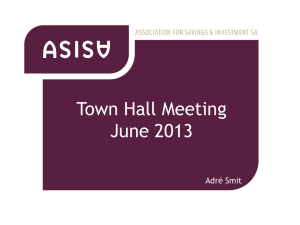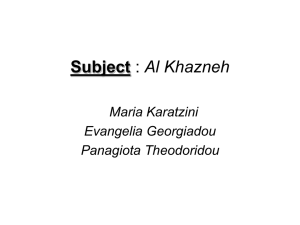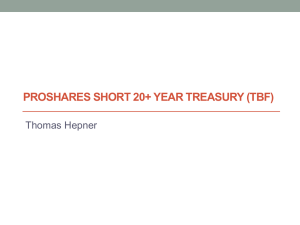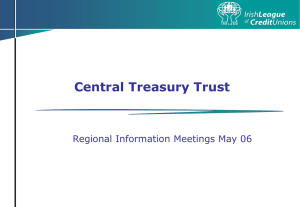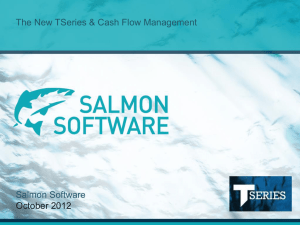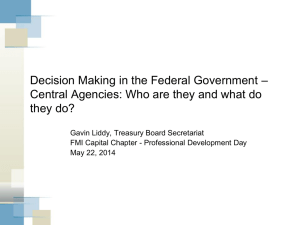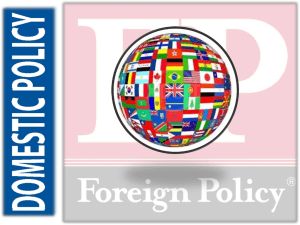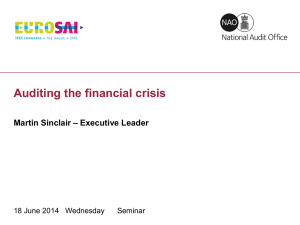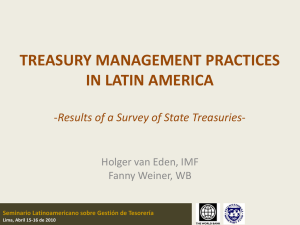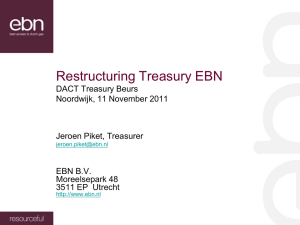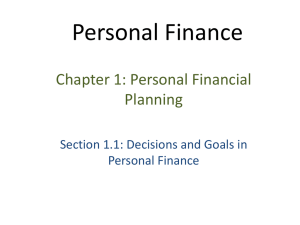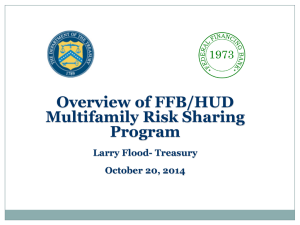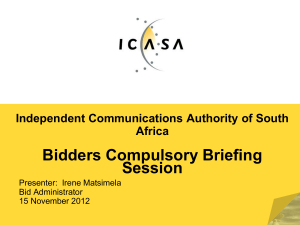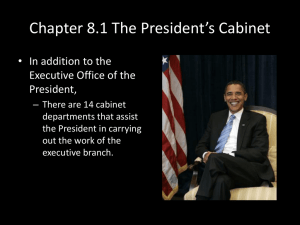Heritage experience - Australasian Mutuals Institute
advertisement
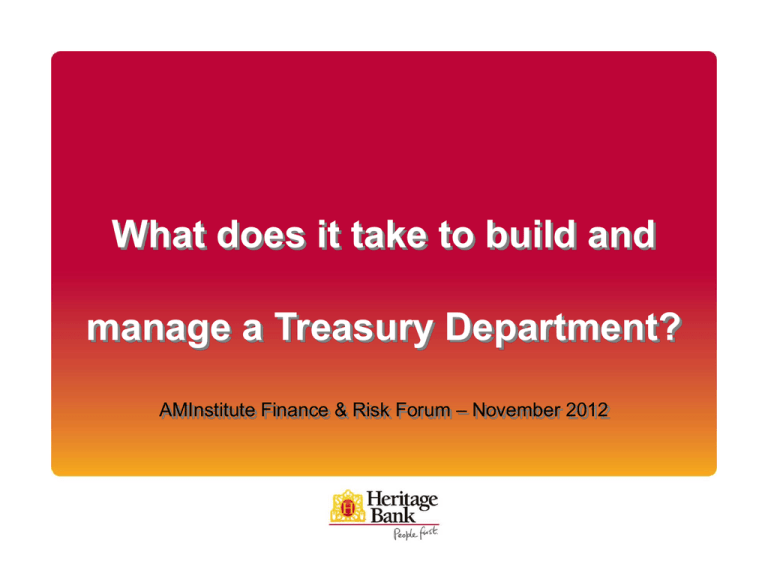
What does it take to build and manage a Treasury Department? AMInstitute Finance & Risk Forum – November 2012 Why build a Treasury? Economic environment has changed Drive for assets replaced by focus on funding Competition for retail funding increased NIM volatility Existing Treasury arrangements not meeting needs Limited focus means no pricing power/higher cost No control/options over innovation Poor service from support providers No identity/independence Independent Treasury function provides opportunity for funding diversity 2 Why Build a Treasury? Greater focus on Managing Risk by APRA, Boards and Management Specialist area – you need expertise To provide information on interest rates, the financial markets and the economy to other departments, management and the Board – for key business decision making 3 What does a Treasury do? Treasury is a service provider for the business A business’ risk appetite determines role of Treasury Treasury as a core business function for ADIs Liquidity Management – cash flow management & investing Financial Risk Management – NIM, pricing & hedging Capital Management – cap adequacy, hybrids Debt issuing – refinancing & funding Treasury can also be a profit centre Buy and sell financial instruments e.g. bonds, swaps/options Trade market exposures Provide intermediary services for internal & external stakeholders 4 What does a Treasury do? Manage Risks Identify, Quantify & Manage (Hedging) Liquidity Funding Plan, Daily cashflow, Liquidity Investments (Securities, Duration, Counterparties) Market Gap, VaR, EaR, NIM Credit Treasury Counterparties, large exposures Capital Management IMB Structure Securitisation 5 What does a Treasury do? cont. Minimise Risk IMB Treasury only uses hedging to reduce positions IMB Treasury does NOT trade IMB Treasury does use Balance Sheet Positioning e.g. you want to be long fixed assets in a falling interest rate environment (loans & investments) you do not want to be long fixed assets in a rising interest rate environment 6 How do you set up a Treasury? Approach will differ depending on circumstances but likely to require the following key milestones: 1. Gain support of key decision-makers 2. Acquire skills 3. Define responsibilities 4. Determine structure 5. Build infrastructure & operating framework 7 1. Support of decision-makers Treasury not core retail – clear objectives essential Significant commitment of time & money required Requires a “champion” & Board support Heritage experience No Treasury function Business model changed Asset growth funded by Securitisation Liquidity & capital pressure Securitisation warehouse filling up – Plan B? Treasurer hired within 6 months 8 IMB Experience IMB Treasury has always had strong support from management and the Board Gradual evolution IMB Treasury established early 1990’s Small team – 4.2 FTE (Treasury liquidity investments – 2.2 FTE and funding – 2FTE) reporting to CFO I replaced Manager Treasury in 2000 Implemented Treasury system in 2002 Securitisation first issue 2003 Risk Management brought in house in 2005 Expanded into other areas e.g. debt funding, capital instruments 9 2. Acquire skills Timing debatable – depends on workload of CFO Having right skills assists at subsequent stages Heritage experience Skill set required defined by business priorities: 1. 2. 3. 4. 5. Securitisation Capital management Funding & debt issuance Liquidity management Financial risk management Treasurer hired – previously Capital Markets Dealer & Securitisation Manager at BoQ 10 IMB Experience Gradual evolution Business case (cost/benefit analysis) to employ additional staff to enhance treasury team I had a trading background I had to learn new skills - securitisation, interest rate risk management You don’t always need to buy staff, you can train internally 11 3. Define responsibilities Heritage experience Treasurer reporting to CFO Business risk appetite required separation of duties Treasury functions existed but no framework Liquidity, investing & financial risk managed in Accounts Limited issuing undertaken – subordinated debt Governance thin – no Board policies for Treasury Treasury created as a distinct department Immediately assumed existing processes Back office within Accounts Settlement processes separate but complimentary 12 IMB Experience Clear segregation of duties Front Office, Back Office (Settlements), Middle Office Policies and Procedures Develop over time Reporting lines Treasurer reports to CFO Governance Committees – ALCO, Pricing 13 4. Determine Structure Structure dictated by business needs Processes evolve as priorities change & skills sets develop Heritage experience 1. Dealing – 3 staff Day to day liquidity management & investment activities Market interface & pricing input Debt issuance & hedge execution 2. Structured Finance – 2 staff Securitisation issuing & maintenance Term debt issuing & program maintenance 3. Financial Risk Management – 2 staff Balance sheet forecasting, hedging strategies & scenario testing Key financial metrics & analysis 4. Settlements – 2 staff Austraclear, Swift, ASL etc. 14 Dealing team Structured Finance Financial Risk Management 15 IMB Experience Need to consider: What markets do you want to be in? – Middle markets, Capital markets, Securitisation, Broker This will help determine: no. of staff, level of knowledge/experience you need Outsourcing Risk, Liquidity Investments, Settlements Cost/Benefit analysis 16 IMB Experience Dealers – 3 FTE BDM’s – 3 FTE Risk – 1 FTE Settlements (Back Office) – 1 FTE Accounts (Middle Office) – 1 FTE Securitisation Issued by Treasury but maintained by Accounts (Middle Office) Need to consider: Do you buy vs. Do you train? 17 5. Build infrastructure & operating framework Heritage experience Basic requirements first – workflows set up in Excel Operating framework developed over time Day to day liquidity streamlined Financial risk management recalibrated Securitisation structures created & administration simplified Back office formalised and capabilities augmented Board policies written for capital, liquidity, financial risk Settlement capabilities upgraded Infrastructure developed as sophistication grows Workflow management system acquired – limit control, separate activities Balance sheet management system – value add through analysis Funding strategy evolving – Credit ratings, debt program, new deals 18 IMB Experience - Systems 12 years ago Now Spreadsheets Treasury deal capture Monitoring credit exposures Deal Confirmation and settlement advices Hedge Accounting Value at Risk Sensitivity (PVbp) Scenario Analysis 19 Gap Reporting IMB Experience - Systems Treasury Treasury deal capture Monitoring credit exposures ALM Deal Confirmation and settlement advices Value at Risk Hedge Accounting Scenario Analysis 20 Sensitivity (PVbp) Gap Reporting EaR/NIM Funds Transfer Pricing Cashflow/ Liquidity Credit Analysis Capital Modelling Prepayment /Repayment IMB Experience Systems evolved over time – gradual process Straight Through Processing (Front Office to Back Office) Complete Balance Sheet picture requires all data (Treasury and Retail) IT Knowledge Outsourcing Do you Buy vs. Do you Rent Cost/Benefit Analysis IMB Risk Management experience We wanted knowledge in house 21 Ongoing management issues Heritage experience Learning to manage the balance sheet Good back office is critical Sustainable funding = $3 of potential funds for every $1 invested Understand the importance of refinance risk Must commit resources to electronic payments channels Develop an investor base that supports the business Balancing competing interests of liquidity/capital/NIM Successful deals are only good if they can be refinanced It’s a merry-go-round with no finish line Continual search for improved performance Ongoing refinement of processes, skills & outputs 22 Challenges Regulation/Compliance VaR/EaR ex. Costs Capital, Liquidity, “Deposit War” Majors attack on Retail deposits - Core funding of mutuals Funding Diversification Sources, Duration Balance Sheet Management All risks together “Best Practice” – bar is a lot higher now 23 New Funding Paradigm 24 Summary Establishing a Treasury Department requires commitment & resources Benefits include: Funding mix diversity – NIM stability Better focus = better governance Sophistication & skills in key financial operations Market profile & credibility Difficulties include: Costs versus return Finding the right skill set Market volatility e.g. credit rating Ongoing stakeholder management 25 Summary Structure Staff Systems Cost/Benefit Costs will increase Some benefits are unquantifiable 26 Comment Must consider the use of Brokers, Advisers and Consultants Depends on what you want to do, the size of your organisation, short term vs long term view You learn more doing it yourself Brokers You need to control your direction and not be talked into something the Broker wants you to do just because others are doing it Use them to help your business - Do not let them run your business Investing in FRN’s (credit risk - Europe, liquidity risk, capital loss?) “don’t be tempted into new products to boost profitability unless you understand the risk and have the skill set to manage” Stephen Glenfield – CDO’s Borrowing from professional clients – “hot money” 27 Cont. APRA – Supervise for Risk Liquidity – liquid asset, credit risk, HQLA return? The market is always right? NCD’s – issued at margin over BBSW Develop a Treasury Markets Culture Have a view/opinion Talk to each other/deal with each other 28

